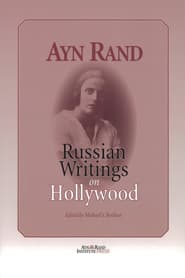

Trapped in the totalitarian dictatorship of Soviet Russia, the young Ayn Rand (then, Alisa Rosenbaum) found a lifeline in the form of foreign movies. They offered a glimpse of the world abroad and of life’s potential, fueling the spirit of a passionate girl starved for glamour and romanticism.
In her late teens, Rand kept a diary in which she recorded every movie she saw, along with a list of cast, director, date and a grade rating. And in 1924, she entered the State Institute for Cinematography, in Leningrad, with the intention of studying screenwriting.
Shortly before leaving Russia forever, the teenaged Ayn Rand pursued her love of cinema even further, writing two articles about the American film industry.
These articles — virtually unknown during Rand’s lifetime — were made available in English for the first time with the 1999 publication of Russian Writings on Hollywood. The book also contains facsimiles of the original Russian booklets and a copy (and English translation) of Rand’s movie diary.
— Ayn Rand, quoted in Michael S. Berliner, ed., “Introduction,” Russian Writings on Hollywood
Hiding in one of the many cartons of papers left by Ayn Rand after her death was an essay she had written and published in 1925 under her original name, Alisa Rosenbaum, while attending school. The essay, “Pola Negri,” was a biographical article on her favorite movie actress at the time, and was Rand’s first-ever published work.
The second essay, a booklet called Hollywood: American City of Movies, was published in 1926, six months after Rand left Russia forever. In a letter to her daughter, Rand’s mother describes her surprise at seeing the booklet for sale in a shop window and surmised that it must have been published without permission.
Along with these two very early essays, Russian Writings on Hollywood contains Rand’s movie diary and her list of favorite actors and actresses of the time.
The book provides a glimpse into the passionately held values of the young Ayn Rand — ten years before her first novel, We the Living, was published. We see Rand’s admiration for Hollywood and the movie industry of which she would later become a part.
“About fifteen years ago, on a sunny day, . . . a man of small height, soft movement, and imperious voice arrived in a suburb of Los Angeles. He cast his eyes upon the green hills, upon the transparent air, upon the dazzling sun, and set up a shed on the outskirts of Los Angeles. . . .
“The city was Hollywood. The man — Cecil DeMille.
“Today strict, business streets of concrete stretch through the suburbs of Los Angeles. Skyscrapers pierce the sky. People, for whom 24 hours is not enough time in a day, stream in a constant wave over its boulevards, smooth as marble. It is difficult for them to talk with one another, because the noise of automobiles drowns out their voices. Shining, elegant Fords and Rolls-Royces fly, flickering, as the frames of one continuous movie reel. And the sun strikes the blazing windows of enormous, snow-white studios.
“Every night an electric glow rises over the city.
“Bright lights, like the names of movie stars which ignite them, scatter across the gay streets. Hundreds of floodlights pierce the darkness.”
— Alisa Rosenbaum, Hollywood: American City of Movies, Dina Garmong, trans.
Ayn Rand was a teenager when Soviet authorities first allowed foreign films to be shown in Russian movie theaters. Through the shots of streets and skylines contained there, these films offered her the first precious glimpses of a land that resonated with her vision of the ideal: America.
America, a land dedicated to protecting individual rights, stood in sharp contrast to the collectivism of communist Russia. Unlike the conditions she was subjected to in Russia, America was a place free, as she later put it, of “physical compulsion, coercion or interference by the government.”
To Rand, America represented a place where innovation thrived and anybody could achieve success through hard work and ambition. Within these writings, we see the beginnings of Rand’s admiration for the country she would later describe as the “greatest, the noblest and, in its original founding principles, the only moral country in the history of the world.”
Motion pictures played an important role in Ayn Rand’s personal and professional life. After sailing to America in 1926, Rand spent six months with relatives in Chicago. While there, she worked on silent film scripts and took these — along with $100 — with her when she left for Hollywood.
She was quickly hired as an extra (by Cecil DeMille, a director she admired and wrote about in her booklet on Hollywood) and later sold her first script, “Red Pawn,” while working in the wardrobe department of a movie studio.
Rand saw motion pictures as an important art form, but one that hadn’t yet reached its full potential. She expressed a desire to bring her view of man to the screen and recapture the “style and spirit” she saw in those movies from her teenage years. During the early part of her career, she worked on the screenplays of several films, including an adaptation of her novel The Fountainhead, which was made into a movie and released in 1949.
Ayn Rand decided at age nine that she would be a writer. The two essays in Russian Writings on Hollywood, written when she was a teenager, and still known as Alisa Rosenbaum, represent her first published works.
Although these essays are not part of Rand’s mature corpus, they shed light on her development as a writer and thinker.
This is especially evident in the description of her favorite actress at the time: Pola Negri. In Rand’s view, Negri did not become a star because of her good looks, but because of her ability to capture the spirit of each role she undertook. “She is a woman who did not struggle for her fame. . . . She came and she conquered.”
In her later writings, it is clear that Ayn Rand has a unique view of what qualities make a hero or heroine. Russian Writings on Hollywood allows us to see some of the actors, actresses, writers and directors a teenaged Rand admired.
Indications of the qualities she would come to regard as heroic, such as a productive ambition, deep passion for life and uncompromising integrity, can be seen in her descriptions of the men and women in these early essays.
This is especially true in her description of Cecil DeMille, a Hollywood director and an idol of Rand’s, who she would later meet by happenstance on her first day in Hollywood. DeMille is described as a man who rose to do great things, guided by his own vision.
The scenes of American cities with boulevards “smooth as marble,” where “shining, elegant” cars flew by, were in sharp contrast to the life a young Ayn Rand was experiencing in Soviet Russia. Movies represented a spiritual escape from a country she would later describe as “an accidental cesspool of civilization.”
In a 1948 letter to a favorite silent-screen actress, Mia May, Rand writes: “I find it very difficult to tell you how grateful I am for the pictures you sent me. . . . It is my youth brought back — or, rather, a reward for the very difficult years of my youth, when the name ‘Mia May’ and the things you represented were the symbol of the only beauty and relief I had while being imprisoned in hell.”
In We the Living, Rand tells the story of a girl growing up in Soviet Russia — and the way in which the concept “abroad” functions as a lifeline — in her first and most autobiographical novel.